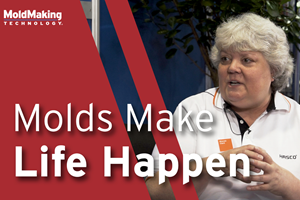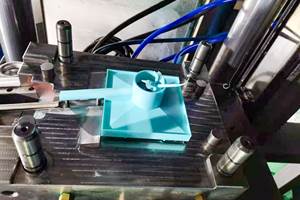Delving into Rapid Prototyping Technologies Attracts New Customers
Offering RP services and investing in technologies that help to constantly improve those services can help you reach potential new markets and allow your company to push the envelope of mold building technology.
Share
Adding value to your services is one way today’s mold manufacturers diversify—and thrive—in today’s difficult economic times. Offering rapid manufacturing services shows your customers that you are on the cutting edge of today’s technology. Two companies—Rexam Mold Manufacturing (RMM) and Linear Mold and Engineering—have taken these technologies to the next level by introducing new elements to these rapid manufacturing technologies.
Buffalo Grove, IL-based RRM provides prototype development tooling using a recently purchased mold cooling technology to deliver even more value to its customers. At Linear Mold (Livonia, MI), the company realized that its additive fabrication services resulted in the company’s ability to produce metal prototype parts to its customers, which has opened up new doors for the company and allowed them to grow their customer base.
The Cutting Edge
According to Wayne Grassel, Business Unit Manager for RMM, the integration of Ritemp cooling technology with its RP services puts RMM “on the leading edge of mold building technology by providing its customers with an economical introduction to the technology during the mold development process. This delivers exceptional value to our customers. With RMM having a development license, the customer is not required to purchase this license on each and every mold that he wants to produce.
“This addition to our services is a result of our commitment to innovation and the desire to remain a leader in the mold manufacturing arena,” Grassel continues. “This area attracted us because there are only a few areas that you can cut costs. I am talking about the molding of the product, which is an important part of the supply chain. Our customers are looking for someone who can produce the parts for them as inexpensively as possible without loss of quality. Assuming the molder has good equipment and his cavitation levels are maintained, there are only two things you can do as a mold manufacturer. You either light weight the part or you use different types of materials in the mold to transfer heat as fast as possible. RiTemp offers an alternative technology to remove heat at a much faster rate, thus reducing the cycle times.”
Fortunately, using this cooling technology in mold manufacturing does not involve the purchase of new equipment. “You just need to change the way you think about your mold construction,” Grassel explains. “Normally your mold requires cooling lines which you would drill or machine into your mold base or mold component from a manifold or external piping. You now will have a closed cooling chamber, within the mold, that envelopes mold surfaces.”
RiTemp’s engineering group was very supportive during the learning process, Grassel adds. “They assisted us with the design. All we provided was a normal mold cooling design and they helped us converting it to their specifications. They also have assisted us with the assembly of the mold and followed us through sampling process.”
Grassel also points out that RMM—currently a leading provider of consumer packaging and beverage cans—can now serve additional markets like blow molding as it currently is a large supplier of blown bottles. “As a mold builder, sometimes there are markets that are difficult to compete in,” Grassel states. “Blow molding is one area that RiTemp can give you the ability to take a step in front of your competition. We are looking at bringing more value to our existing customers. With today’s economy, companies are tending to pull back capital for new programs, but seem to be putting money into areas that will improve output. Whether by keeping their cavitations up, redesigning parts for cost reduction or through faster cycle times, these are the areas that we want to partake in with our customers.”
Ability to Diversify
At Linear Mold and Engineering, President and CEO John Tenbusch was looking for ways to increase the shop’s output by investing in new technologies. DMLS (direct metal laser sintering) was just starting to be known in North America and Tenbusch knew that with the bulk of the company’s outsourcing budget going toward EDM, it could take advantage of this additive fabrication method.
Adding RP also resulted in the company becoming one of only a handful of service providers in North America for metal prototype parts. When they are not producing inserts for their molds, the machines are running at full capacity to provide prototype parts for the medical, dental, aerospace, military and weapons industries. These customers have also begun to look at Linear as a source for prototype and production injection molds for their products. “Companies that normally would not have sought us out as a tool supplier have been introduced to us via this technology,” Tenbusch explains. “This has been another huge step toward becoming diversified beyond the once dominating auto industry of Michigan.”
Looking Ahead
RMM has just completed its first prototype mold using the new technology, and has commitments from two customers to proceed with prototype molds. Marketing efforts are underway through magazine articles, sales, an upcoming website and future case studies.
Tenbusch is optimistic about the future. “The addition of this new diversified customer base has put Linear in very good position in terms of future growth,” he stresses. “We will continue to look for ways to improve our ability to cater to the cost and timing requirements of our current, new and future customers.”
“Once the molds are out there being run, I see tremendous growth opportunities like the ones I already mentioned,” RMM’s Grassel concludes. “This industry has always been cautious with change, but there are those that believe that unless you are willing to fill the needs of your customers you will be left by the wayside. Customers need—and have always wanted—new technology in the moldmaking arena and RiTemp I believe is one of these areas for serious consideration.”
Related Content
VIDEO: How Molds Make Life Happen
Hasco America Inc.'s Engineering Manager, Brenda Clark, brings her lifelong expertise to our MoldMaking Technology audience by shedding light on new innovations, what skills are needed to be successful in the industry and how Molds Make Life Happen.
Read MoreEvaluating Metal Powders for Conformally Cooled Mold Inserts
Mechanical properties and design software techniques reveal the benefits of a modified high thermal conductivity metal powder for 3D printing in moldmaking.
Read MoreHow to Supply Cooling to Additive Tooling
Additive tooling provides limitless options for cooling a mold’s difficult-to-cool areas.
Read MoreLarge Hybrid Steel Insert Solves Deformation, Dimensionality, Cycle Time Problems
DMLS printers using metal additive powders selected by Linear AMS to produce high-quality, accurate, consistent 3D-printed mold components with certification and traceability.
Read MoreRead Next
Analysis of the Additive Manufacturing (AM) Industry Worldwide, Part I
After more than two decades of research, development and use, the additive manufacturing industry continues to expand with the introduction of new technologies, methods and applications. Additive processes have had a tremendous impact on design and manufacturing, and this impact will continue to grow in the coming years.
Read MoreHow to Use Continuing Education to Remain Competitive in Moldmaking
Continued training helps moldmakers make tooling decisions and properly use the latest cutting tool to efficiently machine high-quality molds.
Read MoreAre You a Moldmaker Considering 3D Printing? Consider the 3D Printing Workshop at NPE2024
Presentations will cover 3D printing for mold tooling, material innovation, product development, bridge production and full-scale, high-volume additive manufacturing.
Read More






.jpg;maxWidth=300;quality=90)






_300x250 4.png;maxWidth=300;quality=90)











